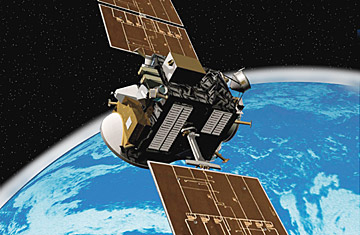
Cruise control: Artist's depiction of the craft on its way to the asteroid belt
[This article consists of a complex diagram. Please see hardcopy of magazine.] The designers at NASA are preparing to fly what may be the feeblest spacecraft they've ever built--and they couldn't be prouder of it. Never mind the decades of unmanned probes that have gone roaring into the void at tens of thousands of miles per hour, fire streaming from their tails. The new ship will putt-putt into interplanetary space under the power--if that's even the word--of an engine that accelerates by barely 15 m.p.h. (24 km/h) per day, or zero to 60 in more than half a week. Yet the places the ship is going--and the remarkable way it will get there--could open an entire new era in space travel.
The odd duck of a spacecraft, scheduled to launch in September, is known simply as Dawn, and its destinations are the asteroid Vesta and the dwarf planet Ceres, mysterious bodies orbiting in the belt of rubble that circles the sun between Mars and Venus. NASA vehicles have been this way before, but they've usually been just passing through on their way to the planets in the outer solar system. This time the asteroid belt itself will be the destination, and the ship will get there courtesy of the young technology of ion propulsion.
Like any other spacecraft, Dawn will have to be muscled off its launchpad by a conventional rocket burning conventional propellant. Once it climbs to near Earth space, however, everything will change. Of all the things that add weight to a spacecraft, fuel presents the most problems. The farther you're going, the more propellant you need, but every pound of it you add means more mass the engine must propel, which requires more fuel still, and on and on. A spacecraft like Dawn, which is designed not just to fly by its two targets but also to settle into orbit around them, would require a massive load of onboard gas.
"We're going to two bodies," says systems engineer Marc Rayman of NASA's Jet Propulsion Laboratory in Pasadena, Calif. "If we wanted to go to even one of them, we'd normally have to carry several tons of propellant and would need one of the largest rockets in the U.S. inventory to get it off the ground."
Ion propulsion sidesteps that whole mess. Rather than rely on common combustible fuel, it uses xenon gas, a comparatively light 937 lbs. (425 kg) of it loaded into a compact 72-gal. (273 L) tank. A jolt of electricity energizes the gas, causing xenon ions to shoot out the back of the ship at 77,000 m.p.h. (124,000 km/h). A stream of charged atoms has somewhat less oomph than a burst of fire--less force than the weight of a single piece of paper, in fact--but over time it adds up. "It's acceleration with patience," says Rayman. "In the four days it takes to increase speed by 60 m.p.h., we'll use only 2 lbs. of propellant. If we keep thrusting, however, we can achieve extremely high speed." Indeed they can. By the time Dawn completes its four-year journey to the neighborhood of Vesta, a trip made longer by the slow acceleration, it will have sped up by 24,500 m.p.h. (39,400 km/h) and will be tearing along as fast as any interplanetary ship has ever propelled itself.
There's good reason to spend so much time and money--Dawn carries a $446 million price tag--getting to Ceres and Vesta. The composition and reflectivity of the bodies suggest they were formed within the first 3 million years of the solar system's life, whereas Earth was something of a late arrival, coming along about 27 million years later. A close look at Ceres and Vesta, then, is a close look at a local cosmos that our planet wasn't even around to see. "These two objects are our best opportunity for going back into time," says Christopher Russell, professor of geophysics and space physics at UCLA.
Not only are the little worlds old, but they're also odd. Vesta, which measures about 330 miles (531 km) at maximum diameter, or roughly the width of Arizona, is thought to account for 1 out of 20 meteorites that strike Earth, while Ceres, which is closer to us, provides none. One reason might be simply that Vesta is made of denser stuff, material that when it breaks away can remain intact through the long journey to Earth. "Ceres is not very thick," says Russell, "and whenever there's an impact, it knocks off ice and a lot of dust that doesn't survive the trip." That ice makes Ceres intriguing in its own way. At 590 miles (950 km) in diameter, it could be a surprisingly dynamic place, with an ice crust over a rocky interior and watery flows periodically resurfacing it.
To ensure that it can uncover the secrets of both worlds, Dawn will ease itself into a six-month orbit around Vesta, then climb gradually back out and fly on to Ceres, which it will orbit for about five months. This is the part that would have been simply too fuel intensive for an ordinary spacecraft. Dawn, by contrast, should have enough xenon left over after its Ceres stay that mission planners might even consider sending it on to a third destination.
No matter what the ship eventually reveals about Vesta and Ceres, NASA believes a successful mission could help establish ion technology as the propulsion system of choice for any mission in which the need for fuel is high and the need for speed is low. "Because of ion propulsion," says Rayman, "Dawn can explore the last unexplored worlds in the solar system." Not bad on a single small tank of gas.
